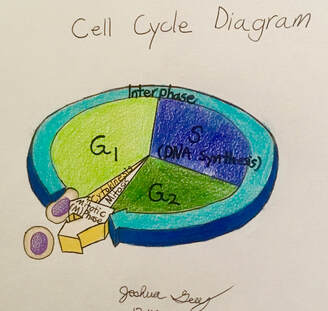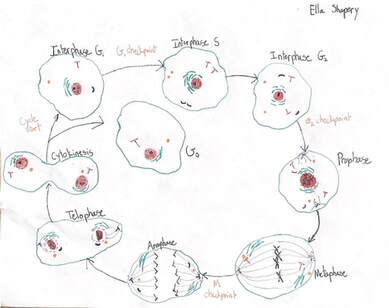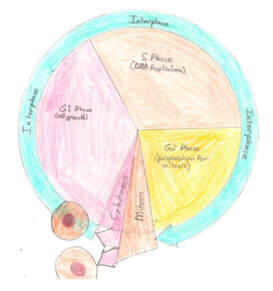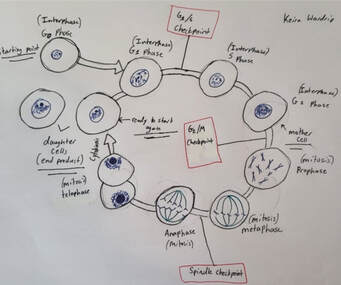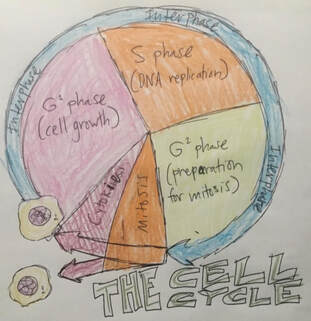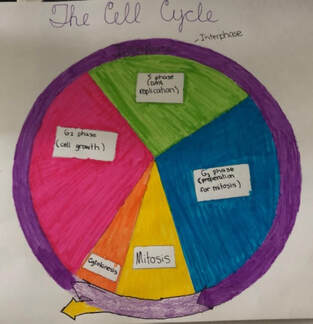Unit 5: Mitosis and the Cell Cycle
Reading
BJU Biology: Review 2.6, and then read Ch. 5A - "Genes, Chromosomes, and Cell Division"
AP Classroom: Unit 4 - "Cell Communication and Cell Cycle"
AP Princeton Review: Ch. 7 Cell Communication and the Cell Cycle
Topics
Labs which illustrate the topics
We will do as many of these as time allows.
BJU Biology: Review 2.6, and then read Ch. 5A - "Genes, Chromosomes, and Cell Division"
AP Classroom: Unit 4 - "Cell Communication and Cell Cycle"
AP Princeton Review: Ch. 7 Cell Communication and the Cell Cycle
Topics
- The cell cycle (I Played My Accordion Today)
- DNA replication
- Mitosis
Labs which illustrate the topics
We will do as many of these as time allows.
- Gene Switches lab (the Lac Operon)
- Henrietta Lacks Case Study (HeLa cells)
- The Eukaryotic Cell Cycle and Cancer weblab. (HHMI) Instructions are posted in the next unit.
- Karyotyping weblab (Univ. of Arizona)
- Pipe cleaner mitosis lab (works very well as a visual aid)
Introduction
Cells divide and multiply. They do this 1) to replace damaged tissues, 2) to replace old worn-out cells, 3) to permit growth of an organism, and 4) to simply replicate themselves, as in the case of bacteria.
When a cell divides, it must first replicate all its DNA so that each daughter cell receives a complete copy. DNA replication occurs in all living organisms - humans, whales, finches, corn plants, and fruit flies.
Copying of the DNA is accomplished by the process of DNA replication - also known as DNA synthesis. This occurs in the S phase of the cell cycle. After that particular cell - let's say a skin cell - completes its synthesis phase, it then moves on the G2 phase - hopefully passes through the G2 quality checkpoint - and ultimately moves on to the mitosis phase where it actually divides.
In eukaryotes (humans, pea plants, dolphins, and yeast) DNA replication occurs in the nucleus - after all, that's where the DNA resides.
In prokaryotes (think: bacteria) DNA replication occurs right out in the cytoplasm itself, because that's where bacterial DNA resides.
Cells divide and multiply. They do this 1) to replace damaged tissues, 2) to replace old worn-out cells, 3) to permit growth of an organism, and 4) to simply replicate themselves, as in the case of bacteria.
When a cell divides, it must first replicate all its DNA so that each daughter cell receives a complete copy. DNA replication occurs in all living organisms - humans, whales, finches, corn plants, and fruit flies.
Copying of the DNA is accomplished by the process of DNA replication - also known as DNA synthesis. This occurs in the S phase of the cell cycle. After that particular cell - let's say a skin cell - completes its synthesis phase, it then moves on the G2 phase - hopefully passes through the G2 quality checkpoint - and ultimately moves on to the mitosis phase where it actually divides.
In eukaryotes (humans, pea plants, dolphins, and yeast) DNA replication occurs in the nucleus - after all, that's where the DNA resides.
In prokaryotes (think: bacteria) DNA replication occurs right out in the cytoplasm itself, because that's where bacterial DNA resides.
The cell cycle: "I Played My Accordion Today"
- Interphase
- Prophase
- Metaphase
- Anaphase
- Telophase
| Lecture slides: Mitosis |
| 10._dna_replication_lecture_slides_2023.pptx |
Below: another excellent 4-min. video on Mitosis (Cell Division)
Homework
| 7._the_cell_cycle_homework_questions_rev_2023__ |
| 10._dna_replication_homework_questions_2023.docx |
HeLa Cells case study
Our Henrietta Lacks case study will explore a controversial episode involving a cancer patient
Our Henrietta Lacks case study will explore a controversial episode involving a cancer patient
| henrietta_lacks_case_study_ |

